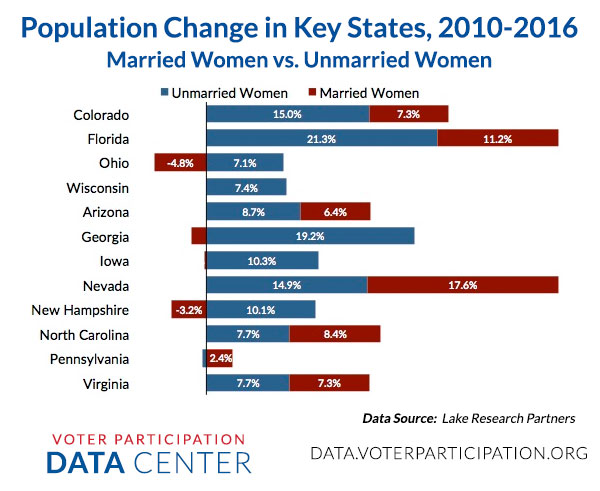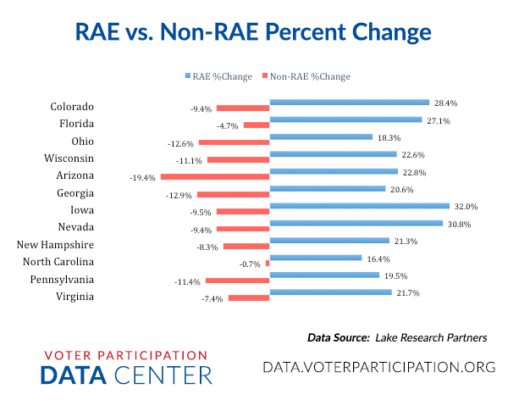Unmarried Women: Growing in Numbers and the Power to Decide 2016 Elections
There are more than 58 million single women eligible to vote this November. For the first time ever, there are more single women than married women eligible to vote, and their numbers continue to grow nationally and in key states. And as the new poll of nine battleground states conducted for Women’s Voices Women Vote Action Fund shows, single women could determine the outcome of the presidential election and U.S. Senate races down-ballot.

Chart: Rising American Electorate vs. Non-RAE Percent Change
This chart showing the growth of the Rising American Electorate – unmarried women, people of color, and Millennials – in key states between 2010 and 2016 demonstrates quite clearly how broadly and quickly the face of America is changing.

All information was provided by Lake Research Partners.
2016 Primary Spotlight: June 7 Primary States
Expect major news outlets to declare Hillary Clinton the presumptive Democratic nominee on Tuesday night, June 7 — primary day for voters in six states. Even though California, with its 475 pledged delegates and 73 super delegates at stake in the Democratic primary, has been called “the big enchilada” by Senator Bernie Sanders, Sec. Clinton is expected to reach the 2,383 delegates required for a majority even before Californians’ votes are counted, once New Jersey’s polls close at 8 EDT.
Even so, California will still be one of the most closely watched Democratic presidential primaries in modern times. California’s voter rolls grew by almost 650,000 in the final six weeks of registration, and 3/4 of those new voters were Democrats. Of the 646,220 people who registered in the final rush — between April 8 and May 23 — 76% became Democrats who want to weigh-in in the race between Senator Sanders and Secretary Clinton.
Seventy percent of the eligible voters in California and New Mexico, one of the other June 7 primary states, are members of the Rising American Electorate –unmarried women, people of color, and millennials. 28% of California’s eligible voters and 35% of New Mexico’s vote-eligible population are Latinos.
Learn more about unmarried women in the June 7 primary states:
The Atlantic: Will Single Women Transform America?
In her book All the Single Ladies, Rebecca Traister takes a long look at the history of marriage in the United States.
“The unprecedented rise in independent, unmarried women demands shifts in power dynamics and policy.”
See the video.
2016 Primary Spotlight: Indiana
Indiana’s standalone primary on May 3 has emerged as a must-win for Republican Ted Cruz. Both Donald Trump and Hillary Clinton come into the state with momentum from their multi-state wins last Tuesday. There are 57 delegates at stake in Indiana’s GOP primary, and 92 in the Democratic primary. The Rising American Electorate (RAE)—the unmarried women, people of color, and millennials who make up 57% of eligible voters nationally—make up only 46% of Indiana’s voting-eligible population. Unmarried women make up the largest percentage of the RAE in Indiana. Learn more about their lives.
2016 Primary Spotlight: April 26 Primaries (CT, DE, MD, PA, RI)
The five presidential primaries next Tuesday are all on the east coast—Connecticut, Delaware, Maryland, Pennsylvania, and Rhode Island. These primaries could mark the end of Sen. Bernie Sanders’s presidential campaign and move the Republicans closer to a contested convention.
Here’s what’s at stake:
- Connecticut: 70 Democratic delegates (awarded proportionally); 28 Republican (awarded proportionallyif no candidate gets >50%, winner-take-all if one candidate does)
The Rising American Electorate—unmarried women, people of color, and millennials—make up the majority of voters in Maryland (56%) and Delaware (56%) and close to half the electorate in the other primary states (49% in Connecticut, 47% in Pennsylvania, and 48% in Rhode Island).
Forty percent of the eligible voters in Maryland are people of color (40%), the largest share of any state voting on Tuesday. 30% of MD’s eligible voters are African Americans—and the participation of these voters could decide the tightly-contested Democratic primary race for the open U.S. Senate seat between Representatives Chris Van Hollen and Donna Edwards. According to Washington Post polling, voters are split along racial lines between Van Hollen, a white man, and Edwards, an African-American woman. The Post poll shows that Edwards has a 51-point lead among African-American women.
The VPC has prepared in-depth profiles on unmarried women in each of Tuesday’s five primary states:
Connecticut
Delaware
Maryland
Pennsylvania
Rhode Island
2016 Primary Spotlight: New York
For the first time in decades, both the Democratic and Republican primaries in New York on Tuesday, April 19 will be consequential. The nominees are usually already decided this late into the primary calendar. But candidates from both parties have a lot riding the Tuesday’s outcome of their closed primary elections. (Independents cannot vote in the New York primaries.)
New York is the second most delegate-rich state for Democrats with a mix of 291 pledged, at-large and uncommitted delegates up for grabs. On the Republican side, New York has the fourth-highest number of delegates, with 95 delegates at stake.
The Rising American Electorate—unmarried women, people of color, and millennials—could have a significant effect on the outcome in New York, where they make up 61% of the eligible voters in the state. (Nationally, the RAE accounts for 57% of eligible voters.) People of color also make up a higher portion of eligible voters in New York (34%) than they do nationally (30%) and unmarried women are also a larger share of eligible voters in New York: 29% versus 26% nationally.
Equal Pay Day 2016: Unmarried Women, Race, and the #WageGap
Today is Equal Pay Day: a date that symbolizes how far into 2016 the average woman would have to work just to make as much money as the average man made in 2015. Because the average woman makes 80¢ for every $1 a man makes, she’d have to work three extra months—all the way through March 2016—just to make as much as the average man made in 2015.
As we pointed out in yesterday’s post, while the wage gap for women overall is awful, the wage gap for unmarried women is even worse; the average unmarried woman makes only 60¢ for every $1 a man makes.
But unmarried women of color are the ones who suffer the most from the wage gap: For every $1 the average man makes, an unmarried African-American woman makes 52¢, an unmarried Latina makes 48¢, and an unmarried Native American woman makes only 47¢. Those numbers look even worse when we consider how long the average woman in each of those groups would have to work just to make the same amount of money the average man made in 2015:

That’s just depressing.
And it’s not going to change until policymakers at the state and federal level acknowledge that there’s a problem, and take action to solve it. That’s why efforts like Equal Pay Day are so important, to put pressure on officials to do something about the wage gap.
Please do your part and spread the word.
Read the full memo from the Voter Participation Center and Lake Research Partners about the current wage gap and presidential candidates’ response to the wage gap: Equal Pay Day for Unmarried Women (PDF)
Equal Pay Day 2016: Unmarried Women and the #WageGap by State
Tomorrow, April 12, is Equal Pay Day: a date that symbolizes how far into 2016 the average woman would have to work just to make as much money as the average man made in 2015. Women make, on average, 80¢ for every $1 a man makes—a gap that adds up over time, costing the average woman $430,480 in lost income over a 40-year career.
But as terrible as that is, it’s even worse for unmarried women. The average unmarried woman makes only 60¢ for every $1 a man makes.
To find out what the wage gap for unmarried women is in your state, check out this interactive map:
The Wage Gap for Unmarried Women

Pay Gap by State
Yes, the wage gap for women, unmarried women, and unmarried women of color is real—and it’s a problem that won’t go away unless we do something. We need to demand that our policymakers and legislators at the state and federal level take action to end the wage gap.
Read the full memo from the Voter Participation Center and Lake Research Partners about the current wage gap and presidential candidates’ response to the wage gap: Equal Pay Day for Unmarried Women (PDF)
2016 Primary Spotlight: Wisconsin
The Wisconsin primaries, which will be held on April 5, mark the first presidential primary contests of April 2016. For the Democrats, 86 pledged delegates are at stake. They will be allocated proportionally.
For the Republicans, 42 pledged delegates are up for grabs. They will be allocated on a winner-take-all basis, meaning whichever candidate receives the most votes will take home all 42 of Wisconsin’s pledged delegates.
One of the key trends we have been tracking is turnout. Young people have been unusually engaged this year in both the Democratic and the Republican primaries. According to analysis by the Center for Information and Research on Civic Learning and Engagement at Tufts University, Donald Trump drew more young voters than his Republican rivals but he received slightly fewer votes from young people than former Secretary of State Hillary Clinton. Senator Bernie Sanders, the overwhelming favorite of millennials, has received more votes from the young than Mr. Trump and Sec. Clinton combined. In Wisconsin, millennials make up about a quarter of the electorate.
Unmarried women, a key constituency this election, make up about 24 percent of the eligible voters in WI. A new poll from the Women’s Voices Women Vote Action Fund (our sister organization) shows unmarried women have an increased interest in the election. For more information about unmarried women in Wisconsin, read our Wisconsin report.

